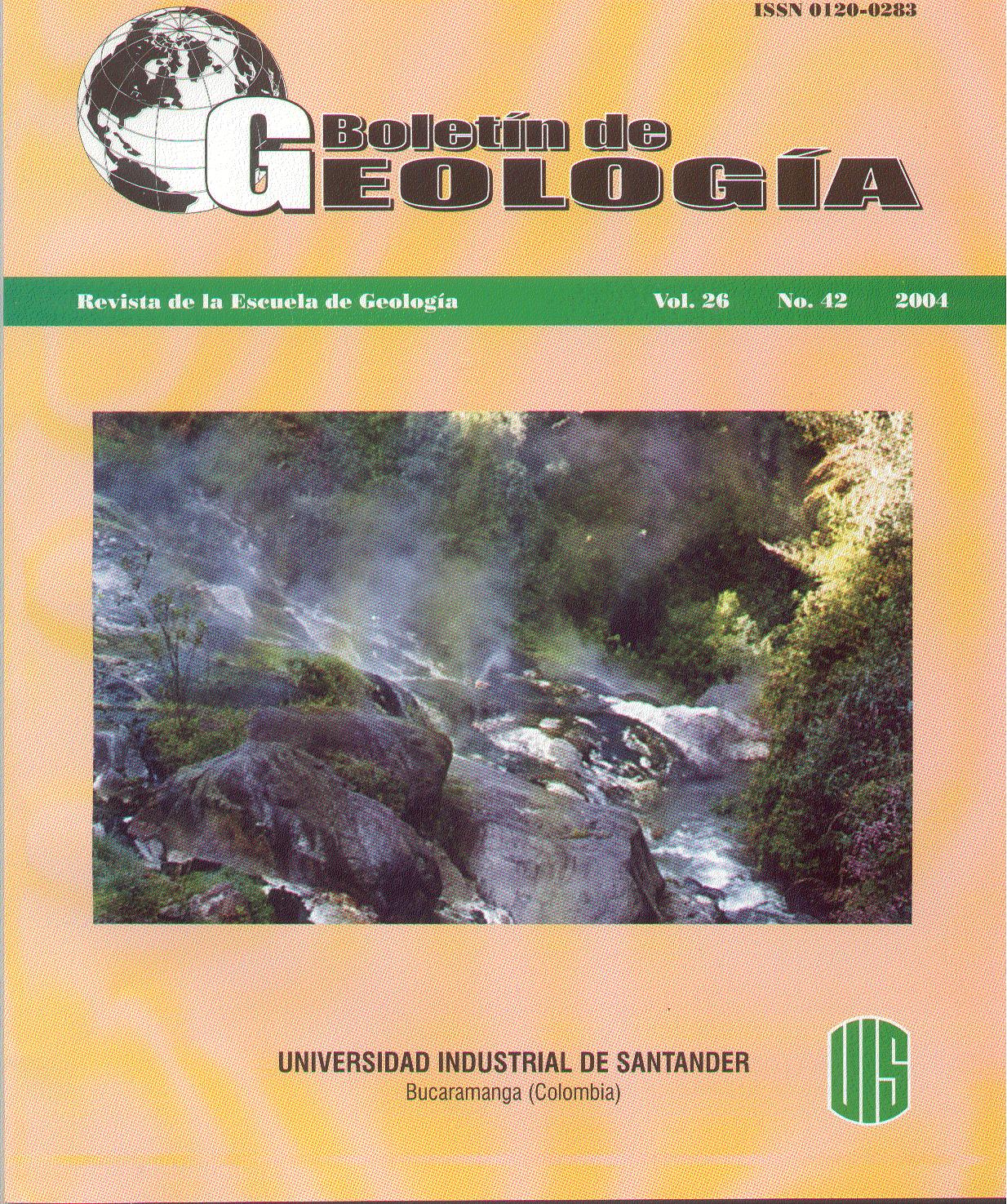Publicado 2004-03-25
Palabras clave
- Younger Dryas,
- El Abra,
- Paleoceanografía,
- Paleoclimatología,
- Cuaternario
Cómo citar
Resumen
En el norte de Suramérica y el Caribe existen indicios de la presencia de un evento frío y seco, análogo al “Younger Dryas” (YD) del Atlántico Norte. Las evidencias más contundentes se encuentran en los registros geoquímicos y micropaleontológicos marinos de la Cuenca del Cariaco (Venezuela) y del Abanico del Amazonas, junto con registros palinológicos de alta resolución de los Andes del Norte. Durante este periodo, las tierras altas de los Andes del norte y las cordilleras de Centro América experimentaron descensos de temperatura y pluviosidad y las áreas costeras del norte de Suramérica registraron eventos de surgencia más intensos. Las condiciones climáticas y oceanográficas se encuentran aparentemente relacionadas con un desplazamiento hacia el sur de la Zona de Convergencia Intertropical (ITCZ) y un fortalecimiento de los vientos Alisios del noreste.
Descargas
Referencias
Baker, P.A., Rigsby, C.A., Seltzer, G.O., Fritz, S.C.,Lowenstein, T.K., Bacher, N.P., Veliz, C. (2001). Tropicalclimate changes at millennial and orbital timescales onthe Bolivian Altiplano. Nature, Vol. 409, pp. 698-701
Balsam, W.L., Otto-Bliesner, B.L., Deaton, B.C. (1995).Modern and last glacial maximum eolian sedimentationpatterns in the Atlantic Ocean interpreted from iron oxidecontent. Paleoceanographay, Vol. 10, N. 5, pp. 493-507
Behling, H., Hooghiemstra, H. (2001). Neotropicalsavanna environments in space and time: Late Quaternaryinterhemispheric comparisons. En: Markgraf, V.Interhemispheric Climate Linkages. Academic Press,U.S.A, pp. 307-323
Behling, H., Hooghiemstra, H. (1998). Late Quaternarypalaeoecology and palaeoclimatology from pollen recordsof the savannas of the Llanos Orientales in Colombia.Palaeogeography, Palaeoclimatology, Palaeoecology Vol.139, pp. 251-267
Berrío, J.C., Behling, H., Willie, M., Hooghiemstra, H.(2000). Climate history from 9 new pollen records of theColombian savannas since the last glacial maximum; atransect through the Llanos Orientales. Symposium PastGlobal Changes. Amsterdam, The Netherlands, pp. 1-2
Berrío, J.C., Hooghiemstra, H., Marchant, R., Rangel,O. (2002). Late-glacial and Holocene history of the dryforest area in the south Colombian Cauca Valley. Journalof Quaternary Science Vol. 17, N. 7, pp. 667-682.Bowles, F.A., Fleischer, P. (1985). Orinoco and Amazonriver sediment input to the eastern Caribbean Basin.Marine Geology Vol. 68, pp. 53-72
Bradbury, J.P., Grosjean, M., Stine, S., Sylvestre, F.(2001). Full and late glacial lake records along the PEPTransect: Their role in developing interhemisphericpaleoclimate interactions. En: Markgraf, V.Interhemispheric Climate Linkages. Academic Press,U.S.A, pp. 265-291
Bradbury, J.P., Leyden, B., Salgado-Labouriau, M.,Lewis, W.M., Schubert, C., Binford, M.W., Frey, D.G.,Whitehead, D.R., Weibezahn, F.H. (1981). LateQuaternary environmental history of Lake Valencia,Venezuela. Science, Vol. 214, pp. 1299-1305
Broecker, W.S. (1995). The Glacial World According toWally. Eldigio Press. Lamont-Doherty Earth Observatoryof Columbia University. U.S.A, 318 p
Bush, M.B., Piperno, D.R., Colinvaux, P.A., De Oliveira,P.E., Krissek, L.A., Miller, M.C., Rowe, W.E. (1992). A14.300 yr paleoecological profile of a lowland tropicallake in Panama. Ecological Monographs, Vol. 62, N. 2,pp. 251-275
Clapperton, C.M., Hall, M., Mothes, P., Hole, M.J., Still,J.W., Helmens, K.F., Kuhry, P., Gemmell, A.M.D.(1997). A Younger Dryas ice-cap in the equatorial Andes.Quaternary Research, Vol. 47, pp. 13-28
Clark, P.U., Pisias, N.G., Stocker, T.F., Weaver, A.J.(2002). The role of thermohaline circulation in abruptclimate change. Nature, Vol. 415, pp. 863-869
Colinvaux, P.A., de Oliveira, P.E. (2000). Palaeoecologyand climate of the Amazon basin during the last glacial cycle.Journal of Quaternary Science, Vol. 15, pp. 347-356
Colinvaux, P.A., de Oliveira, P.E., Bush, M.B. (2000).Amazonian and neotropical plant communities on glacialtime-scales: The failure of the aridity and refugehypotheses. Quaternary Science Reviews, Vol. 19, pp.141-169
Colinvaux, P.A., Bush, M.B., Steinitz-Kannan, M., Miller,M.C. (1997). Glacial and postglacial pollen records fromthe Ecuadorian Andes and Amazon. QuaternaryResearch, Vol. 48, pp. 69-78
Dahl, K., Repeta, D., Goericke, R. (2003).Reconstructing the fitoplancton community structure inthe Cariaco Basin during the Younger Dryas cold eventusing Chlorin Steryl Esters. Geophysical ResearchAbstracts, Vol. 5, N. 01174
Fanning, A.F., Weaver, A.J. (1997). Temporal-geographical meltwater influences on the North AtlanticConveyor: Implications for the Younger Dryas.Paleoceanography, Vol. 12, N. 2, pp. 307-320
Ganopolski, A., Rahmstorf, S. (2001). Rapid changesof glacial climate simulated in a coupled climate model.Nature, Vol. 409, pp. 153-158
Grimm, E.C., Lozano, S., Behling, H., Markgraf, V.(2001). Holocene vegetation and climate variability in theAmericas. En: Markgraf, V. Interhemispheric ClimateLinkages. Academic Press, USA, pp. 325-270.Haberle, S.G., Maslin, M.A. (1999). Late Quaternaryvegetation and climate change in the Amazon Basin basedon a 50.000 year pollen record from the Amazon Fan,ODP site 932. Quaternary Research, Vol. 51, pp. 27-38.
Hall, J.M. (2002). Barium and Lithium in Foraminifera:Glacial-interglacial Changes in the North Atlantic. PhDDissertation. Louisiana State University.(http://etd.lsu.edu:8085/docs/available/etd-0710102-192931/).
Harris, S.E., Mix, A.C. (1999). Pleistocene precipitationbalance in the Amazon Basin recorded in deep seasediments. Quaternary Research, Vol. 51, pp. 14-26
Haug, G.H., Günther, D., Peterson, L.C., Sigman, D.M.,Hughen, K.A., Aeschlimann, B. (2003). Climate and thecollapse of Maya civilization. Science, Vol. 299, pp. 1731-1735
Haug, G.H., Hughen, K.A., Sigman, D.M., Peterson,L.C., Röhl, U. (2001). Southward migration of theconvergence zone through the Holocene. Science, Vol.293, pp. 1304-1308
Herrera, L. F. (2000). Estudio Paleoecológico deltardiglacial y Holoceno en la Depresión Momposina.Fundación ERIGAIE, Bogotá, 71p
Higuera, A., Brenner, M., Hodell, D.A., Curtis, J.H.,Leyden, B.W., Binford, M.W. (1999). A 10,30014C yrRecord of climate and vegetation change from Haiti.Quaternary Research, Vol. 52, pp. 159-170
Hughen, K., Overpeck, J.T., Lehman, S.J., Kashgarian, M.,Southons, J., Peterson, L.C., Alley, R., Sigman, D.M. (1998).Deglacial changes in ocean circulation from an extendedradiocarbon calibration. Nature, Vol. 391, pp. 65-68.Jones, M.H. (1997). Late Quaternary foraminifera fromlower bathyal and abyssal sediments, Gulf of Mexico: Arecord of paleoceanographic change. PhD DissertationAbstract. Louisiana State University.(http://wwwlib.umi.com/dissertations/intrial/gateway)
Jones, R.T., Marshall, J.D. (2002). Lacustrine oxygenisotopic records from temperate Marl Lakes. PAGESNews, Vol. 10, N. 2, pp. 17-19
Kastner, T.P., Goñi, M.A. (2003). Constancy in thevegetation of the Amazon basin during the latePleistocene: Evidence from the organic mattercomposition of Amazon deep sea fan sediments. Geology,Vol. 31, N. 4, pp. 291-294.
Keigwin, L.D., Curry, W.B., Lehman, S.J., Johnsen, S.(1994). The role of the deep ocean in North Atlanticclimate change between 70 and 130 kyr ago. Nature,Vol. 371, pp. 323-326
Kinder, T.H., Heburn, G.W., Green, A.W. (1985). Someaspects of the Caribbean circulation. Marine Geology,Vol. 68, pp. 25-52
